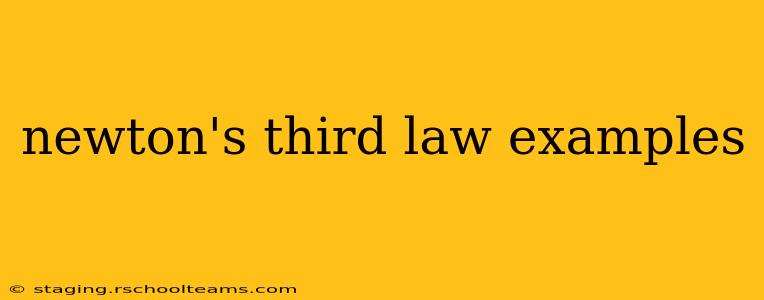Newton's Third Law of Motion, often simplified as "for every action, there's an equal and opposite reaction," is a fundamental principle governing interactions between objects. Understanding this law requires grasping the concept of action-reaction pairs: two forces that are equal in magnitude but opposite in direction, acting on different objects. Let's explore this further with various examples, from the mundane to the more complex.
Everyday Examples of Newton's Third Law
Many everyday actions demonstrate Newton's Third Law subtly, sometimes without us even realizing it. Here are some clear examples:
1. Walking:
When you walk, you push backward on the ground (action). The ground, in turn, pushes forward on your feet with an equal and opposite force (reaction). This forward force propels you forward. Without the ground's reaction force, you wouldn't be able to move.
2. Swimming:
Swimmers propel themselves through water by pushing backward on the water with their hands and feet (action). The water exerts an equal and opposite force forward, pushing the swimmer ahead (reaction).
3. Jumping:
When you jump, you push down on the earth (action). Simultaneously, the earth pushes upward on you with an equal and opposite force (reaction), launching you into the air. This reaction force is what allows you to leave the ground.
4. Rocket Launch:
A rocket engine expels hot gases downward (action). The gases, in turn, exert an upward force on the rocket, propelling it upwards (reaction). This is a powerful demonstration of Newton's Third Law on a larger scale.
5. Rowing a Boat:
Rowing a boat involves pushing the oars backward against the water (action). The water then pushes the oars and consequently the boat forward (reaction).
More Complex Examples and Misconceptions
While the above examples are straightforward, some scenarios might require a deeper understanding:
Misconception: Forces Canceling Each Other Out
A common misconception is that action-reaction pairs cancel each other out. This is incorrect. The forces act on different objects. Consider the rocket launch: the downward force acts on the gases, while the upward force acts on the rocket. They don't cancel because they aren't acting on the same object.
6. Hammer Hitting a Nail:
When you hit a nail with a hammer, the hammer exerts a force on the nail (action), driving it into the wood. Simultaneously, the nail exerts an equal and opposite force on the hammer (reaction). This reaction force is why the hammer might recoil slightly after impact.
7. Magnets:
Two magnets attracting or repelling each other represent action-reaction pairs. One magnet exerts a force on the other (action), and the second magnet exerts an equal and opposite force back on the first (reaction).
Conclusion: The Ubiquity of Newton's Third Law
Newton's Third Law is not just a theoretical concept; it's a fundamental principle governing all interactions in the physical world. Understanding this law provides a deeper insight into the mechanics of motion and how forces interact to create movement and change. From the simple act of walking to the powerful launch of a rocket, action-reaction pairs are constantly at play, shaping our everyday experiences.
